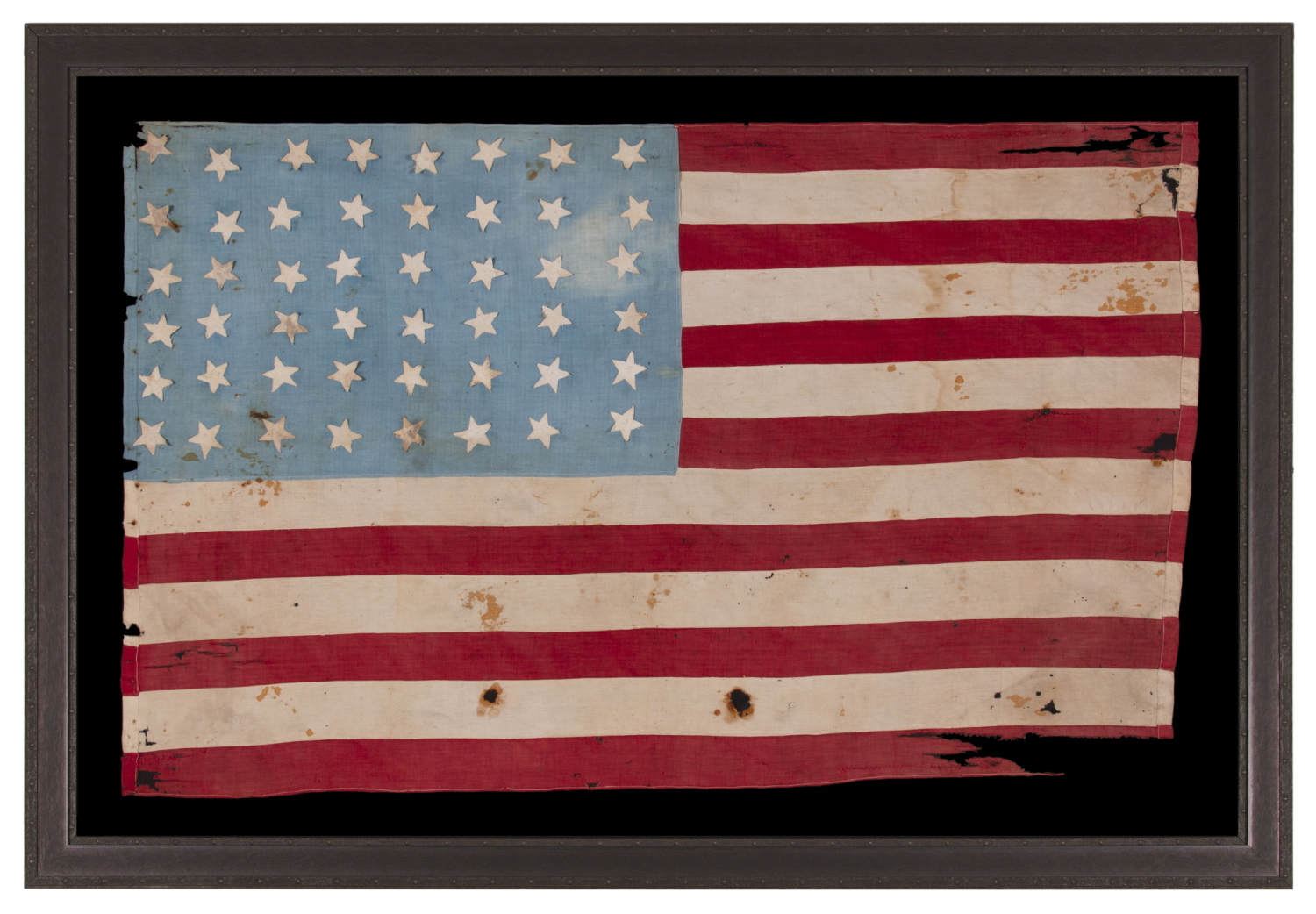
| |
WWII LIBERATION FLAG WITH 48 HASTILY SEWN STARS ON A BEAUTIFUL, CORNFLOWER BLUE CANTON, FOUND BEHIND A CABINET IN A PARIS BASEMENT, MADE TO WELCOME U.S. TROOPS IN FRANCE FOLLOWING LIBERATION FROM THE GERMANS IN 1944, A WONDERFUL EXAMPLE WITH ENDEARING WEAR |
|
| Available: |
Sold |
| Frame Size (H x L): |
Approx. 48.5" x 69.5" |
| Flag Size (H x L): |
36" x 57.25" |
|
| Description....: |
|
American national flag with 48 stars, endearing wear, and wonderful color. Found in a basement in Paris, France, and dating to the WWII era, the flag is indicative of examples produced in make-do fashion by the private citizens of Europe. Such flags were displayed with great emotion upon the arrival of Allied Forces in to one town or city after the next, following the liberation of each community from the Nazi Germany. In France this took place in 1944. Paris itself was liberated that year between August 19th and August 25th.
This is a homemade flag, with stars hastily tacked, by way of hand-stitching, to a beautiful, cornflower blue canton. Made entirely of cotton, the stars are applied to both sides. The striped field was pieced and joined by machine, probably of a treadle-operated variety, given the probability of the lack of electricity during wartime.
The edges of the flag bound by machine on all four sides, with a traditional hem at the hoist and fly ends. The upper and lower edges of flags were seldom sewn in this fashion. Whether homemade or otherwise, selvedge edges of the fabric were typically used in these two locations, so that they didn’t need to be bound. In this case, new cloth was probably not an option. Materials were almost certainly salvaged from whatever was available to the maker.
The flag appears by all means to have been extensively flown. Tacked at five points along the hoist, losses are obvious at these locations. There is some fading in the canton in the area of the second and third rows of stars, at and adjacent to the fly-end edge. There is a general oxidation throughout, in addition to light water staining. More significant stains are present in both the canton and the stripes. There is an area of tears with significant loss at the fly end of the first stripe, accompanied by tears or holes with modest to moderate losses in the 2nd, 7th, 11th, 12th, and 13th stripes, and minor losses elsewhere. The flag has a wonderful, endearing presentation as a result of all of the above, reflective of its wartime use.
Because the number of states, and thus the number of stars on the American flag, were probably not general knowledge outside the United States, liberation flags sometimes didn’t display the correct star count. The stripe count was also sometimes flawed, though less frequently. In this instance, both the star and stripe counts are correct. The 48-star, 13-stripe flag became official in 1912, following the addition of New Mexico and Arizona. It remained the official flag throughout WWI (U.S. involvement 1917-1918), WWII (U.S. involvement 1941-45), and the Korean War (1950-53), until Alaska gained statehood in 1959 and the 49th star was added.
Mounting: The flag was mounted and framed within our own conservation department, which is led by expert staff. We take great care in the mounting and preservation of flags and have framed thousands of examples.
The background fabric is 100% cotton twill, black in color, that has been washed and treated for color-fastness. The extraordinary, 3-part molding is constructed of wood, but has a finish that presents like antique iron. The glazing is U.V. protective plexiglass. Feel free to contact us for more details.
Condition: See above, in the body of the text. Many of my clients prefer early flags to show their age and history of use. |
|
|
|
| Collector Level: |
Advanced Collectors and the Person with Everything |
|
| Flag Type: |
Sewn flag |
|
| Star Count: |
48 |
|
| Earliest Date of Origin: |
1944 |
|
| Latest Date of Origin: |
1944 |
|
| State/Affiliation: |
Arizona |
|
| War Association: |
WW 2 |
|
| Price: |
SOLD |
|
| |
Views: 1265 |
|
|
|

